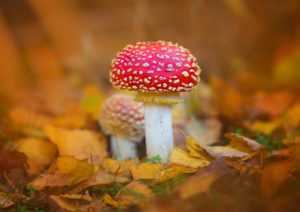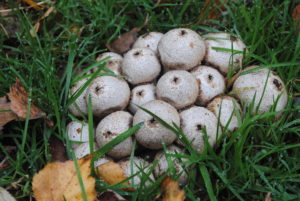What do you think of when you hear the word fungi? For some thoughts might turn to mouth-watering mushrooms, carefully foraged from a supermarket shelf. For others it might conjure images of fairy tales, pixies perched proudly on the red and white caps of towering toadstools. But there’s so much more to these otherworldly organisms than meets the eye.

Fungi come in all kinds of shapes and sizes, from the familiar mushrooms to cups, balls and brackets. These bizarre structures that we’re used to seeing are just the fruiting bodies, which usually only pop up once or twice a year. Like the fruits of a tree, these are temporary, short-lived parts of the larger organism. Their only job is to help the fungus spread.
They do this by releasing microscopic spores, which need to be dispersed in the same way as seeds from a tree and are often spread by the wind. Some fungi fire out their spores like a cannon, launching them into the air. The puffball is a common species well known for its explosive release of spores. When a mature mushroom is compressed by rain, a passing animal or an inquisitive human finger, it puffs out a cloud of spores from a hole in the top.

The main part of the fungus, the part that lives on long after the toadstools have toppled, is hidden within the substrate that the fruiting body grows from, whether that’s the soil, rotting wood, dung or even nuts and seeds. This is a dense, tangled network of threads (called hyphae) that together are known as a mycelium.
These networks can stretch for metres (or in rare cases miles) through the soil, connecting fungi to the roots of trees, grasses and other plants. In most cases, it’s a win-win relationship: the fungus gives the plant nutrients from the soil and the plant supplies the fungus with carbohydrates formed through photosynthesis (the process of making energy from sunlight). Together, they form an underground internet sometimes known as the Wood Wide Web.
The Wood Wide Web can do some incredible things. It’s a social network through which trees can share sugars and nutrients and even information with other trees, as well as with the fungi themselves. Studies have shown that when a tree is under attack, from a harmful fungus or insects like aphids, it can send out a warning to nearby trees through the mycelium. This gives neighbouring trees and plants a chance to prepare and defend themselves against attack.
But just like the internet, it has a darker side, too. Some plants have found a way to exploit it; they have become hackers. The bird’s-nest orchid is a sickly-looking species by the colourful standards of its family. It grows in caramel-coloured spires in the shaded depths of woodlands. Lacking it’s own chlorophyll so can’t photosynthesise to produce food like most plants. Instead, it sucks all it needs from the fungal mycelium connecting its own roots to those of the other plants growing around it, giving nothing in return.

Next time you spot a toadstool sprouting from grass, or a bracket clinging to the bark of a rotting branch, spare a moment to think about the hidden network sprawling beneath your feet, connecting the forest and breathing life into the trees.
Honey Fungus(c) Margaret Holland
fly agaric © Jon Hawkins
Birds-nest orchid (c) Les Binns